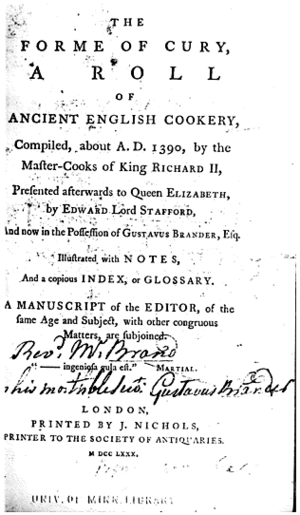Forme of Cury
The Forme of Cury was the name given by Samuel Pegge to a manuscript roll of cookery, attributed to the Master Cooks of King Richard II of England. This name has since come into use for the family of recipes identified by Constance B. Hieatt and Sharon Butler as descending from a single (presumably lost) prototype. It is a well known medieval guide to cooking. It is available in a scholarly edition, Curye on Inglysch. There are nine surviving manuscripts from the "Forme of Cury" family, all dating to the early fifteenth century, and all with slight variations both in number and order of recipes. Two are rolls, seven are codices.
The following is a sample of a recipe taken from Pegge's 18th Century edition of British Library MS Additional 5016, a roll, and, incidentally, one of only two manuscripts to claim authorship by the Royal cooks. The other being University of Manchester English MS 7, which was not known to Hieatt and Butler when they prepared Curye on Inglysch.
- SAWSE MADAME. XXX.
- Take sawge. persel. ysope. and saueray. quinces. and peeres, garlek and Grapes. and fylle the gees þerwith;. and sowe the hole þat no grece come out. and roost hem wel. and kepe the grece þat fallith þerof. take galytyne and grece and do in a possynet, whan the gees buth rosted ynowh; take an smyte hem on pecys. and þat tat is withinne and do it in a possynet and put þerinne wyne if it be to thyk. do þerto powdour of galyngale. powdour douce and salt and boyle the sawse and dresse þe Gees in disshes and lay þe sowe onoward.
An e-text of the Forme of Cury is available from Project Gutenberg. This version was prepared by the Distributed Proofreaders.
